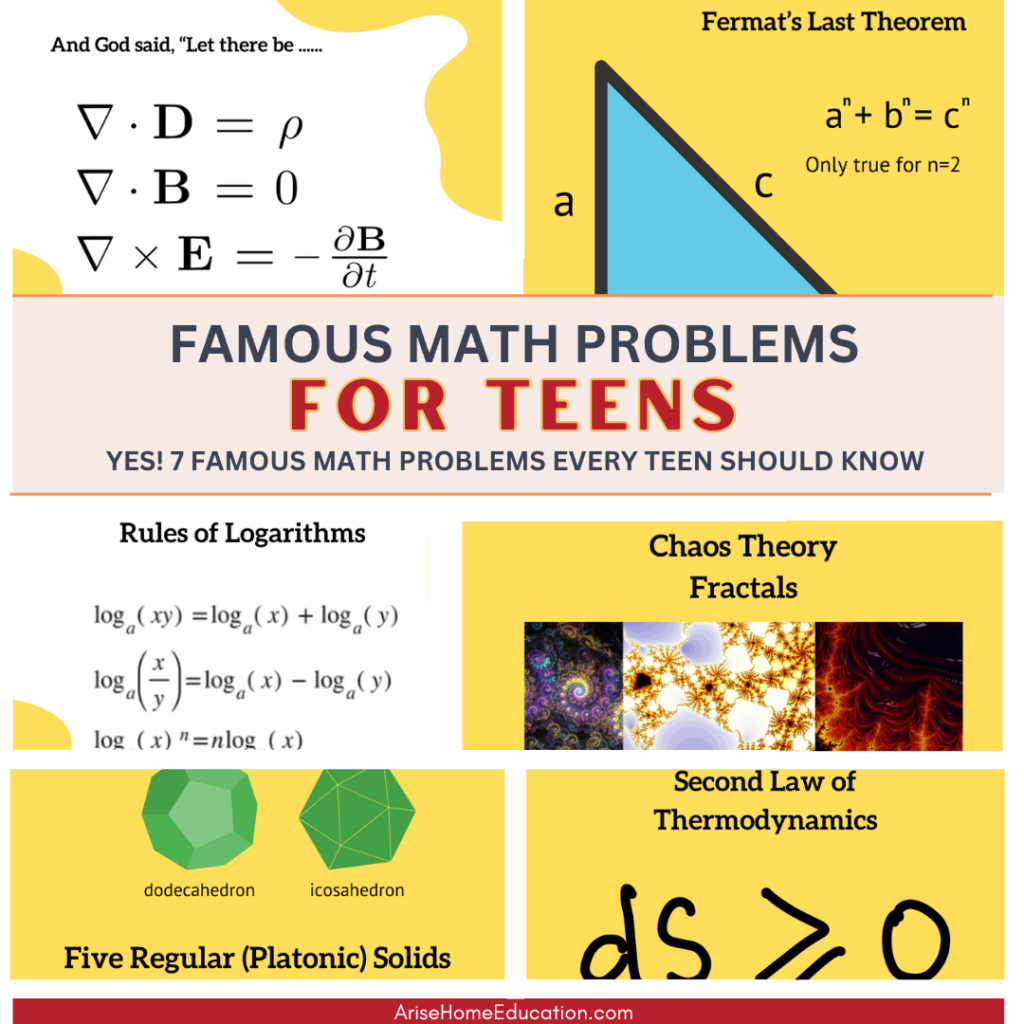The Language of God is Mathematics

It has been said that the language of God is mathematics and that God thinks in numbers. Mathematics governs all the laws of nature. For many, the elegance of mathematics is the ultimate proof of intelligent design. The modern world we live in and enjoy is made possible by the discoveries of mathematicians. Many mathematical discoveries have changed the world, and there are many more discoveries and proofs awaiting the next great mind to uncover. Let us delve into the world of mathematics and the ideas, problems, and discoveries which have changed the world. For any young budding scientist or mathematician many of these famous math problems are foundational for their understanding; many are known by high school kids around the world; others are less famous.
1. Pythagoras and Fermat’s Last Theorem
This is one of the most famous math problems. The ancient Greeks are famous for their mathematical discoveries. Pythagoras Theorem is arguably one of the most famous mathematical concepts in the world. Pythagoras (570 BC- 495 BC) was an ancient Ionian Philosopher and polymath; who also founded his own religion. Today his name is forever linked to the relationship between the lengths of the sides of a right-angled triangle.

However, we now know this relationship was already known by the ancient Babylonians and Indians centuries before Pythagoras was born. Pythagoras is believed to have been the first to identify the five regular solids, these are five solid shapes with all the faces are identical. Although, he may have only actually discovered the first three. The great Greek mathematician Euclid proved that there are only five such polyhedra.

Pythagoras’ Theorem Fascinates For Centuries
Pythagoras Theorem continued to fascinate mathematicians for centuries, as they pondered if it would still hold true if the sides were raised to a higher power. Then in the 17th century, the French mathematician Pierre de Fermat claimed to have proven that Pythagoras only holds when raised to the power 2. However, Fermat was famous for scribbling notes in the margins of books, at his death his notebooks had many little notes that alluded to mathematical discoveries and insights, without rigorous proofs to accompany them.
Mathematicians sought to find proofs to the great man’s ideas. Over the decades and centuries the mysteries of his doodlings were unlocked: some proven, some disproven (even geniuses get it wrong!). The final one was Fermat’s Last Theorem. Many tried to solve it. In the 19th century, the brilliant self-taught female mathematician Sophie Germain tried, and made progress, but was unable to provide a full proof.

Finally, in 1993 British Mathematician Andrew Wiles announced that he had proven one of the most famous math problems – Fermat’s Last Theorem, it took him three years to finally crack the problem. Interestingly, this was only possible with maths that was unknown to Fermat, therefore Fermat himself must have had an incomplete proof of his most famous problem. Dr. Wiles won the Fields Medal for his proof of Fermat, the maths equivalent of the Nobel Prize, for the accomplishment.
2. The Size of the Earth
Another great thinker from ancient Greece was Eratosthenes. Eratosthenes was born in a Greek colony in what is now Libya, North Africa. He studied in Athens. In 236 BC, aged 40, he became the chief librarian at the Library of Alexandria (a highly prominent position in the ancient world).
Eratosthenes was able to use his understanding of mathematics to measure the circumference of the Earth, thus showing it to be spherical over 2000 years ago.
this famous math problem was based on the fact that Eratosthenes knew that on the summer solstice, June 21st, the Sun at noon was directly overhead on the Tropic of Cancer. The city of Syene (Aswan, in modern-day Egypt) is located near the Tropic of Cancer. This meant that at noon there was no shadow. However, at noon in Alexandria, there was a shadow. This could only be the case if the surface of the Earth was curved.
Eratosthenes had a man walk in a straight line between Alexandria and Syene to measure the distance. He then placed a stick in the ground at Alexandria on the solstice and measured the shadow it cast. Using the geometry knowledge he had he was able to calculate the circumference of the Earth to an impressive degree of accuracy for his time.
Eratosthenes also discovered an ancient algorithm for finding prime numbers. Prime numbers have proven to be invaluable tools for mathematicians throughout history, and even today the study of prime numbers is key to many fields of maths. One of the most famous maths problems, which has baffled mathematicians for decades, is the Riemann Hypothesis which is to do with the distribution of prime numbers.
3. The Composition of Saturn’s Rings
This may not be of of the most famous math problems, but it introduces one of the greatest physicists in history. James Clark Maxwell was born in Scotland in 1831 he studied at Edinburgh University and Cambridge. For his final exam at Cambridge, he had to be interviewed by his professor, who would ask difficult questions in the field of mathematics at that time. One such question was pertaining to the composition of Saturn’s rings. There was a competition to see if anyone could discover if they were solid, or made of many particles. Maxwell was able to use mathematics to prove they had to be composed of small particles, due to the gravitational field of Saturn, any solid body would be ripped apart.
Maxwell was taking the language of maths to make predictions about the natural world.
4. Maxwell’s Equation
In Einstein’s study, there were two portraits: Isaac Newton and James Clark Maxwell. Maxwell was regarded by Einstein as one of the greatest minds to have ever lived. It was Maxwell’s work which paved the way for Einstein’s.
Maxwell took the discoveries of Michael Faraday regarding electricity and magnetism and explained them using mathematics. Thus, he discovered Maxwell’s equation of electromagnetism. This set of elegant equations describes electromagnetism radiation, and therefore describes the nature of light! Without Maxwell’s equations, the modern world would not be possible. Every electrical device, all electrical generation, and electronic signals would be impossible without the knowledge contained in these famous math problems.

5. Logarithms
For centuries, complex multiplication and division problems would be done with pen and paper and hours of calculations. This was time-consuming and challenging. However, Scottish mathematician John Napier devised logarithms to help with difficult calculations. He discovered how to take multiplication and division into addition and subtraction. A positive integer can be written as a number 10 raised to a power. By converting them into 10 raised, then the rules of logarithms could be applied, and a logarithm table used to complete the calculation.

Logarithms transformed maths at the time, allowing scientists and engineers to complete complex calculations in an era before calculators. Today, we still used logarithmic scales to measure things like pH and the Richter scale for earthquakes.
6. The Second Law of Thermodynamic
This is another one of the most famous math problems. The simplicity of the equation that describes the Second Law of Thermodynamics should not make us underestimate the weight and importance of this law of nature. This is all to do with a property called Entropy (given the symbol S). Entropy is the measure of disorder in a system. The Second Law states that entropy is always increasing in a closed system; or that a closed system will move to a state of disorder. This also means the arrow of time is always moving forward, a system will not spontaneously go back to order. The Second Law also means that whenever we create local order, this results in greater disorder in the overall system.

7. Chaos Theory
Chaos theory is the study of complex systems, with random behaviour, with inherent repetition. This was first discovered by French mathematician Henri Poincaré, who was working on three-body problems. The butterfly effect is an aspect of chaos theory. This is the idea that if a butterfly beats its wings on one side of the earth, it can cause a hurricane on the other side, although this would be highly improbable. A chaotic system appears random, but is extremely sensitive to its initial condition and is governed by the laws of science, for example, the weather. It is one of those famous math problems that allow contemplation to understand its beauty.
A beautiful representation of Chaos Theory is that of fractals.

The research into chaos theory is a key to unlocking one of the biggest unsolved famous math problems, the Navier-Stokes Equation. This governs the motion of fluids, like air and water.
The Millennium Problems
At the beginning of the new millennium, the Clay Mathematics Institute of Cambridge, Massachusetts (CMI) listed seven of the hardest problems in mathematics and created a prize fund to solve them. Since the turn of the Millennium, only one has been solved the Poincaré Conjecture, this is a complex problem involving the geometry of spheres. However, six of the problems are still to be solved, all of these involve very high-level, pure mathematics, with complex ideas. However, there is a $1 million prize for the solution of each problem, and perhaps a new generation of mathematicians will unlock their mysteries. If you care to know what these famous problems are:
- Birch and Swinnerton-Dyer conjecture (a problem to do with elliptic curves)
- Hodge Conjecture
- Navier-Stokes Equation
- P vs NP
- Riemann Hypothesis, involving Riemann Zeta function (this is to do with the distribution of prime numbers).
- Yang-Mills and the Mass Gap
You may have a child whose ambition is to solve one of these well-known mathematical problems, but do you start them on that journey?
Free Sample Lesson Here
How to Become a Mathematician?
The problems of the Millennium Prize read to 99% of the general population as something mysterious and unfathomable. The mathematics of number theory, complex geometry, abstract algebra, graph theory, and chaos theory are out of the reach of most students. However, for some, this world is a fascination. But how do we nurture a love of mathematics and the inquisitive mind that seeks to understand?
Encourage Curiosity
Young children are inherently curious. Patiently, answer the question, and give space for them. Encourage them to explore the world around them.
Speak Maths
Using the language of maths in the everyday. With very young children, discuss the world around them with the simple terms of maths: greater, less than, more, equals, odd number, even number. Count things on walks. Look for the hidden geometry in the world around you. Look for patterns. As they grow increase this everyday talk to include things like prime numbers, Many complex ideas in mathematics have patterns underpining them.
Make Mathematics Tangible
Teach maths through manipulatives, so they can see and feel the problems. A study showed that students who were good at maths, were those who started out counting on their fingers; and they even continued to visualise maths in this way.
Work on Mathematical Thinking with Famous Math Problems.
Create space for thinking through more difficult problems, Cambridge Univeristy’s Nrich website has a vast library of mathematical thinking resources for all grade levels. They have created great math problems to build mathematical thinking skills. Grappling with a problem for a time, even having unsuccessful attempts at solving difficult problems is vitally important in building a mathematical mind. All the famous mathematicians will stick with a problem for years, sometimes decades.
Make Maths Fun
Using math games is another way to think mathematically. Professional mathematicians say they play with maths. Allow kids to play with numbers, ideas and have space where maths isn’t just doing another page in a textbook.
Maths is Beautiful
Expose your children to the beauty of maths. This can be through mathematical art, the patterns in geometry, of the world of fractals.
Study Mathematicians
Look at the lives and work of famous mathematicians. Look at the colorful stories of the great thinkers who have changed the way to think about the world and understand it.
In studying the ideas that have shaped the world, we can inspire our children to consider their place in shaping the future. All these greats in the field of maths started out as kids, with imaginations filled with wonder at the world around them. How can we as parents harness the imagination, curiosity, and wonder of our kid’s minds as they too study the world of maths? And perhaps they will become the next great mind to set the math world alight.
If your student is keen to study famous females, explore this Famous Female Mathematicians post.
Are Arise Live Classes A Good Fit For Your Teen?
Grab a live lesson bundle and learn about the course, the tutor, and the weekly homework load.
Live Maths Classes At Arise
Arise offers math courses from Pre-GCSE Maths/Middleschool Maths to Advanced Maths including SQA Higher Maths and AS/A Level Maths ( Year 1 Pure Maths & Statistics and Mechanics in 25-26). Check out the varietyof resources and courses below.
Maths Resources
Arise Home Education offers a variety of mathematics resources and courses that will assist your student in preparing for UK exams or earning the required Math credits for USA qualifications.
Homeschool Math Resources & Classes
-
Product on sale
 Pre-iGCSE Maths Year 2Original price was: £360.00.£185.00Current price is: £185.00.
Pre-iGCSE Maths Year 2Original price was: £360.00.£185.00Current price is: £185.00. -
Product on sale
 Maths Revision Bundle | iGCSE Maths 1 Week IntensiveOriginal price was: £140.00.£25.00Current price is: £25.00.
Maths Revision Bundle | iGCSE Maths 1 Week IntensiveOriginal price was: £140.00.£25.00Current price is: £25.00. -
Product on sale
 iGCSE Physics Year 1Original price was: £360.00.£185.00Current price is: £185.00.
iGCSE Physics Year 1Original price was: £360.00.£185.00Current price is: £185.00. -
Product on sale
 iGCSE Physics Year 2Original price was: £360.00.£185.00Current price is: £185.00.
iGCSE Physics Year 2Original price was: £360.00.£185.00Current price is: £185.00. -
Product on sale
 Pre-iGCSE Maths Year 1Original price was: £360.00.£185.00Current price is: £185.00.
Pre-iGCSE Maths Year 1Original price was: £360.00.£185.00Current price is: £185.00. -
 Famous Math Problems: Fibonacci Unit Study£3.55
Famous Math Problems: Fibonacci Unit Study£3.55 -
 Sophie Germaine Math Printable£3.55
Sophie Germaine Math Printable£3.55 -
Product on sale
 iGCSE Maths: Year 2Original price was: £360.00.£185.00Current price is: £185.00.
iGCSE Maths: Year 2Original price was: £360.00.£185.00Current price is: £185.00. -
 Maths Tutoring – Single Session£35.00
Maths Tutoring – Single Session£35.00
Math Freebie
This full freebie is great for all levels of math ability. Have fun with the Hexagon Hop.





